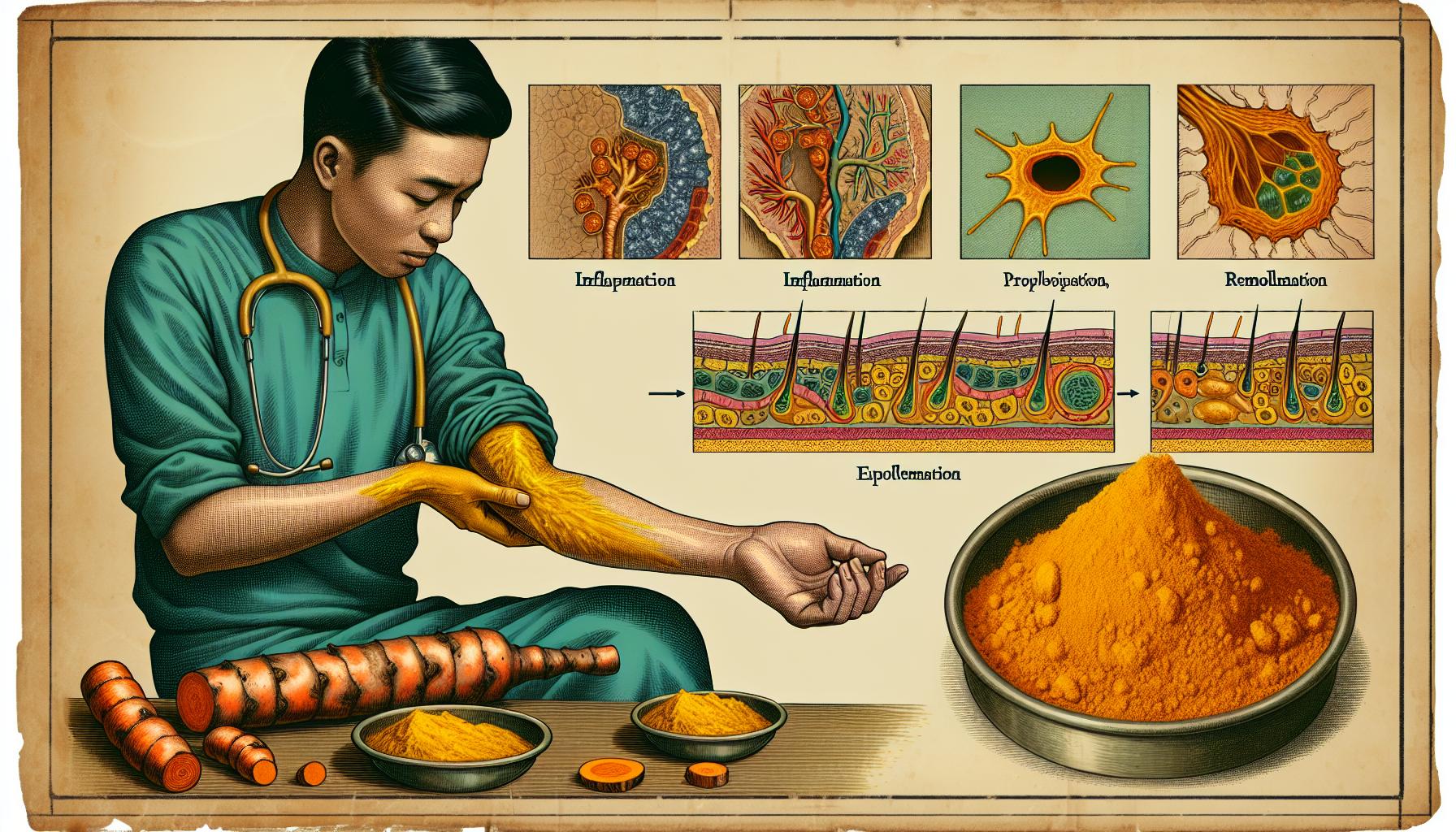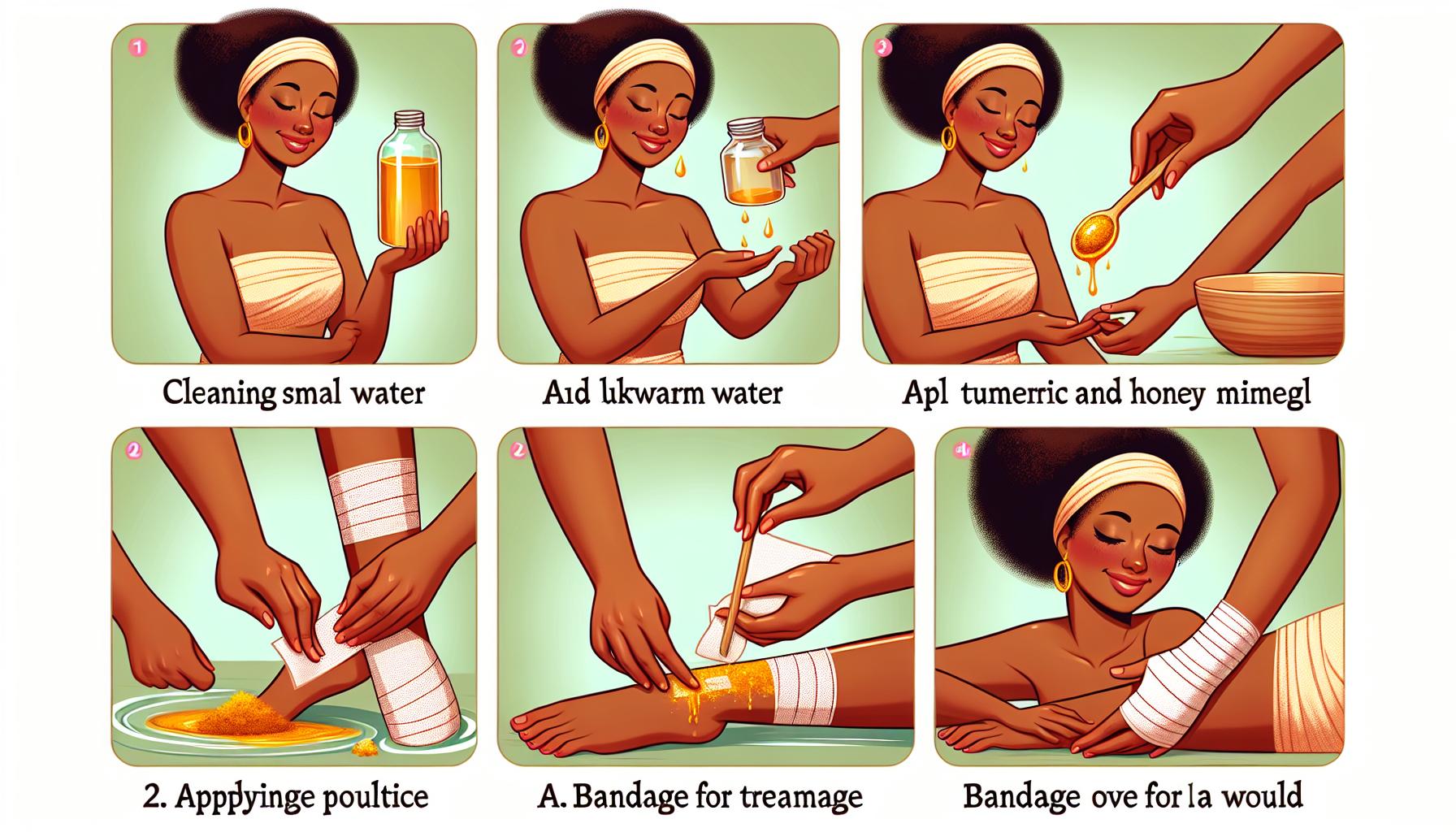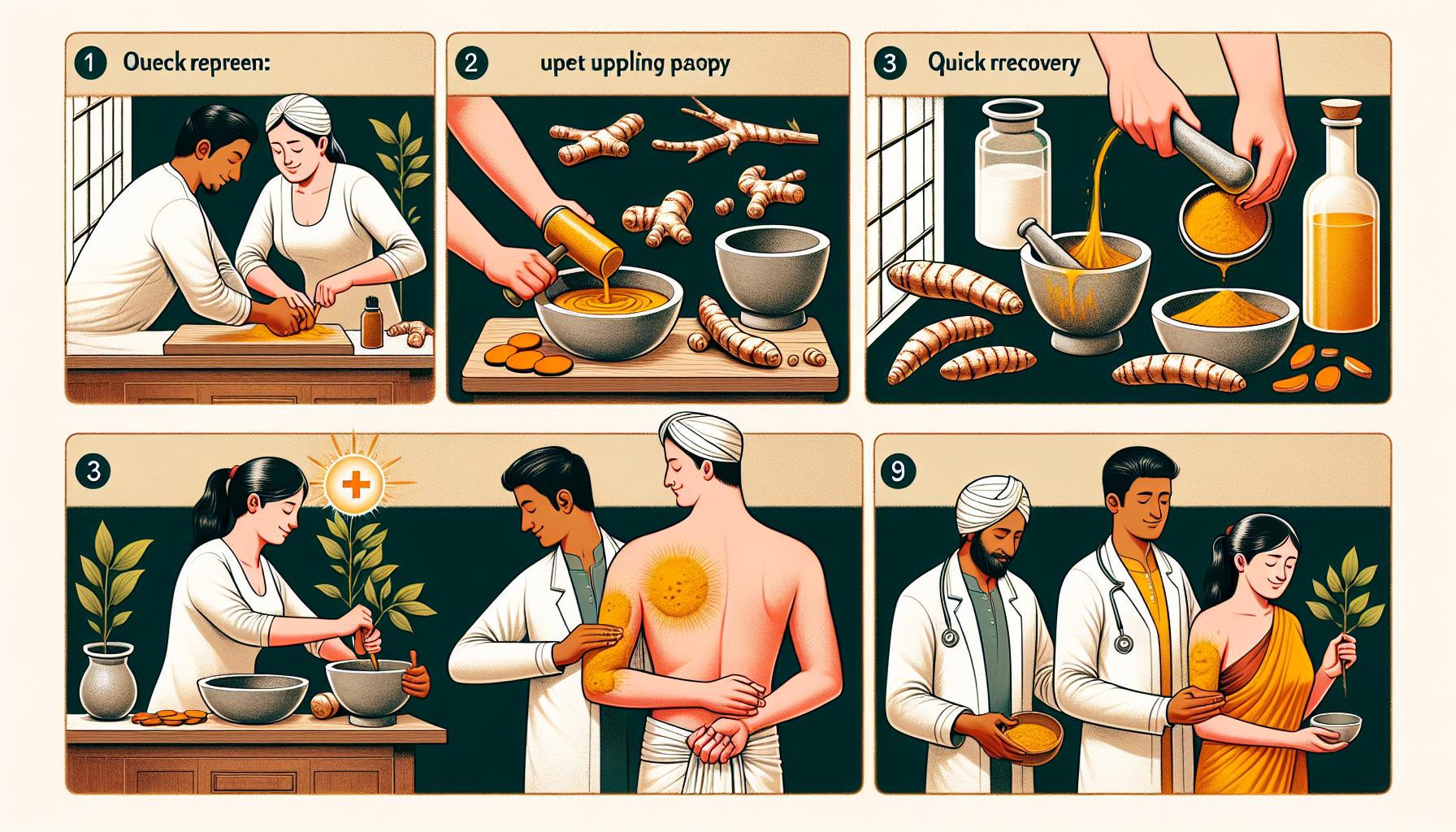Dive into the world of powerful, healing earth’s gems as we uncover the potent medicinal properties of Turmeric – the golden spice from the East that enhances flavour in your cuisine and doubles up as a remedy for wounds and skin irritations. Brimming with anti-inflammatory effects, turmeric’s healing properties could be the answer for your home treatment needs. In this blog post, we pour insights from the YouTube video, “Discover The Power of Turmeric: A Healing Balm for Wounds at Home”, daubing your knowledge palate with an easy, home-made turmeric paste recipe and guidelines on how to use it for treating various skin ailments. Read on to delve into the ancient wisdom of Ayurveda and unlock the therapeutic secrets ensnared in this sunlit spice.
Table of Contents
- Understanding the Wound Healing Power of Turmeric
- Experimenting with Turmeric Paste Recipes for Optimal Effectiveness
- Caring for Wounds with Turmeric: Steps to Safe and Effective Use
- Mastering the Art of Applying Turmeric Paste for Swift Recovery
- Q&A
- The Way Forward
Understanding the Wound Healing Power of Turmeric

Known for its striking orange-yellow hue and vibrant flavor, turmeric is a staple ingredient in many Indian and Asian cuisines. But besides being a culinary delight, this earthy spice also carries potent healing properties, making it an effective home remedy for wounds and skin irritations. The secret lies in curcumin, the primary bioactive substance in turmeric, making it a treasure trove of health benefits. Curcumin boasts antibacterial properties aiding in combating infections, antiseptic properties that help bring down inflammation and discomfort from wounds, and anti-fungal properties that assist in eradicating fungi causing skin infections like athlete’s foot. More impressively, it stimulates wound healing by expediting cell division, promoting tissue repair, and preventing scar formation.
To harness these benefits, one can create a simple turmeric paste at home, which is a mixture of equal parts of turmeric powder and water. However, there are several ways to enhance the efficacy of this blend. For example, incorporating coconut oil and aloe vera gel can increase the soothing effect, baking soda can assist in reducing odor, and sugar or honey can provide additional relief from pain. Here’s a step-by-step guide on how to use the turmeric paste for wound healing:
- Step 1: Clean the wound thoroughly by removing any dirt, debris, or foreign objects, and rinse with water. Apply the turmeric paste topically to your cleaned wound and if desired, cover it with a bandage. Repeat this regularly until your wound heals completely, typically within three to four days.
- Step 2: Mix turmeric powder with water to form a paste. Use a cotton swab or gloved fingers to apply the paste to the wound. Do not apply the paste to open wounds; it should be used on closed, cleaned, and dried out cuts and scrapes.
Note: Make sure to apply sparingly initially until you understand how well your body responds to this remedy, as it could potentially irritate raw skin.
Experimenting with Turmeric Paste Recipes for Optimal Effectiveness
The extraordinary color and flavor of turmeric aren’t the only qualities that make it stand out. It might surprise you to learn that turmeric paste, a humble kitchen ingredient, can serve as an effective remedy for wounds, skin irritations, inflammation, and other skin issues. The magic ingredient in turmeric paste is curcumin, a substance renowned for its plethora of health benefits. Curcumin comes with antibacterial properties, which help to combat body infections. Its natural antiseptic properties offer relief from inflammation and the pain associated with wounds. Moreover, turmeric paste leverages anti-fungal properties, which effectively deal with skin infections, such as athlete’s foot. Lastly, the capacity of the paste to foster wound healing through accelerating cell division, promoting tissue repair, and preventing scarring is simply astounding.
Making a turmeric paste for healing wounds at home is no Herculean task. It requires a blend of turmeric powder and water. However, you can boost its effectiveness and uniquely enrich the paste by customizing the basic recipe. For instance, incorporating ingredients such as coconut oil or aloe vera gel can enhance the paste’s soothing properties. Baking soda is a great addition if you want to control the odor. To alleviate pain, consider adding sugar or honey to your paste. To use, always clean the wound area thoroughly first to remove any dirt or foreign objects. Once clean, apply the turmeric paste topically on your wound, ideally using a cotton swab. Avoid applying the paste directly onto open wounds, and ensure the treated areas are completely dried out. If you need to, cover the area with a bandage. Usually, you’ll notice significant improvement in your wound’s condition with consistent treatment after three to four days.
Caring for Wounds with Turmeric: Steps to Safe and Effective Use

The video outlines a five-step process of using turmeric as a treatment method for wounds and skin irritations. As a popular ingredient in Indian and Asian cuisines, turmeric paste is more than just a culinary staple; it is a potent remedy for various skin conditions. At the core of this stimulating spice lies curcumin, the primary ingredient with numerous health benefits. It boasts antibacterial, antiseptic, and anti-fungal properties effective in fighting infections, reducing pain and inflammation, and warding off fungi associated with skin problems. Even more, curcumin aids in the wound healing process, accelerating cell division, enhancing tissue repair, and minimizing scarring.
Creating an effective turmeric paste for treating wounds involves a blend of turmeric powder and water. For a more potent concoction, the video suggests augmenting this basic recipe with complementary substances such as coconut oil and aloe vera gel, baking soda for odor control, or sugar or honey for pain relief. Use the following step-by-step guide to ensure safe and effective use:
- Step 1: Clean the wound. Begin by removing any dirt, debris, or foreign objects from the wound area. Rinse with water and use a sterile cotton swab to further clean the area.
- Step 2: Apply the turmeric paste. Combine turmeric powder with a small amount of water to form a paste. With gloves on, apply the mixture to the wound using a cotton swab or your fingers. Note, apply this paste only to cleaned and dried, closed wounds, not open cuts or puncture wounds.
Note that the turmeric treatment should only be used sparingly until you ascertain its impact on your body type. The healing process typically lasts three to four days with regular application of the remedy.
Mastering the Art of Applying Turmeric Paste for Swift Recovery

Known for its staple presence in Indian and Asian cuisine, turmeric paste also holds a renowned position in the treatment of wounds and skin irritations. Its vibrant orange-yellow, which can stain your kitchen and hands alike, houses incredible anti-inflammatory effects. Curcumin, the primary ingredient in turmeric paste, is a powerhouse of health benefits, including antibacterial and antiseptic properties to fight infection, reduce inflammation, and soothe pain. Its potent anti-fungal properties can also combat skin infections like athlete’s foot.
The turmeric paste is a simple mixture of turmeric powder and water, providing a versatile base that can be optimized for effectiveness. For instance, you can augment your turmeric paste with a variety of other healing ingredients:
- Coconut Oil and Aloe Vera Gel for added soothing and healing properties
- Baking Soda for controlling odor
- Sugar or Honey for pain relief
To make the most of this remedy, start by thoroughly cleaning the wound. Remove any dirt or foreign objects, rinse with water, and further cleanse using a sterile cotton swab. Apply the turmeric paste topically and cover with a bandage if needed. Regular use can help your wound heal completely within three to four days.
Q&A
Q: What is the main component of turmeric paste used for wound treatment?
A: The main component is curcumin. This ingredient has potent health benefits such as antibacterial, antiseptic, and anti-fungal properties, making it highly effective for wound treatment.
Q: Can I use turmeric pasta directly on an open wound?
A: It’s recommended to use turmeric paste on cleaned and dried out closed cuts and scrapes rather than open wounds. Applying it directly on raw skin may cause irritation.
Q: How do I prepare turmeric paste for wound treatment?
A: To prepare turmeric paste, you would need to mix equal parts of turmeric powder and water. However, the recipe can be varied based on what you want to add, like coconut oil and aloe vera gel for soothing properties, baking soda for odour control, or honey for pain relief.
Q: How long does it usually take for a wound to heal with turmeric paste?
A: It takes about three to four days for a wound to heal completely when using turmeric paste. The paste should be reapplied regularly until healing is complete.
Q: Are there any precautions to take while applying turmeric paste on wounds?
A: Yes, it is advisable to use gloves while applying turmeric paste directly on wounds to prevent turmeric from staining your hands. Also, clean the wound thoroughly before treatment and use a sterile cotton swab for application.
Q: What other benefits does turmeric paste offer for wound care?
A: Turmeric paste has multiple benefits for wound care. In addition to its antibacterial and anti-inflammatory properties, it promotes wound healing by speeding up cell division and tissue repair, and also helps in preventing scarring.
Q: Can turmeric paste be used for other skin irritations?
A: Yes, turmeric paste can also be effectively used in treating skin irritations and fungal infections such as athlete’s foot due to its anti-fungal properties.
The Way Forward
Brightly painted in the sunsets of our Indian stovetops and revered in the secret arts of Ayurvedic medicine, turmeric’s myriad healing abilities are as astonishingly potent as they are colorful. Its rich, warming hue is a testament to the power packed within this spice, relentless against the relentless wounds and skin irritations that assail us, ever ready to restore us back to our unblemished glory.
Turmeric paste has demonstrated its competence in alleviating physical ailments while slyly leaving no trace of its vibrant aura. A most gracious guest, flush with aiding antiseptic, antibacterial, and anti-fungal properties, it can be confidently relied upon to support the body’s defenses. Simultaneously, its faithful commitment to promoting cell division and tissue repairs is the very essence of this healing balm’s comforting presence.
The easily crafted blend of turmeric and water undergoes a transformation into a remedy of great proportions. But the flexibility of its composition allows for the addition of soothing aloe vera, comforting coconut oil, odor-banishing baking soda, and the healing sweetness of sugar or honey. This allows you to personalize your healing journey, catering it to your individual requirements.
Yet, for all the glory of turmeric’s power, we should ensure that we know how to wield it correctly. For cleaning the wound pre-turmeric paste application is just as crucial as said application itself, and taking the necessary precautions to avoid irritations is a testament to our respect for Mother Nature’s remedies.
So, the next time you find yourself reaching for that synthetic salve in the aftermath of a minor injury, remember the golden balm present all along in your spice cabinet. Harness the power that lies within the turmeric through the creation and application of this simple paste, a testament to heritable wisdom and an ode to nature’s healing balm. Be patient- give the turmeric time to work as it bobbs and weaves its antimicrobial magic, healing you from the inside out.
Until next time, remember that you can find health and restoration in the most unsuspecting of places, from your kitchen countertop to the healing world of turmeric.

